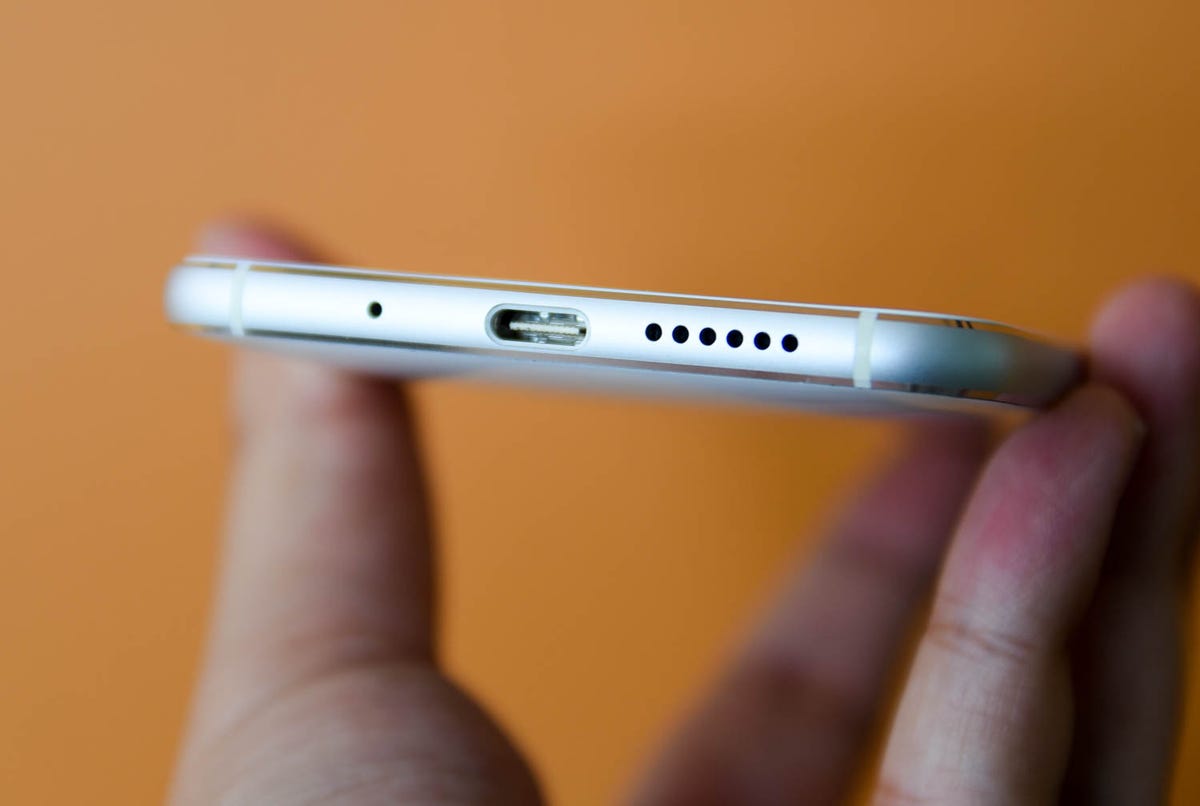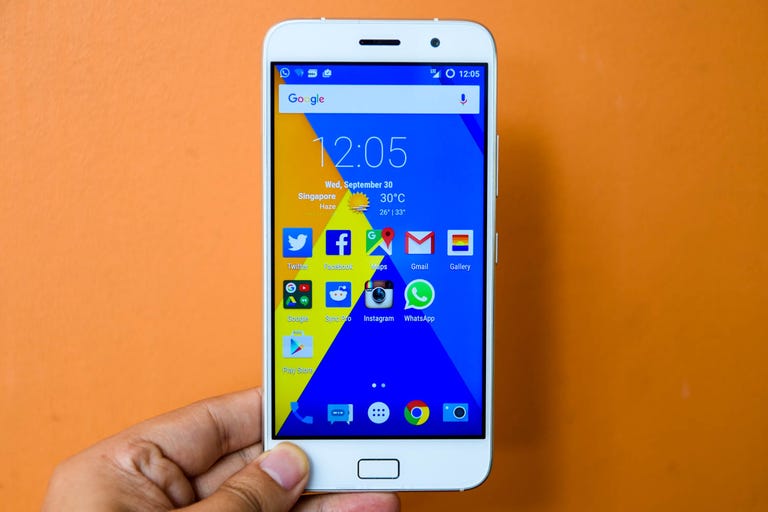 Why You Can Trust CNET
Why You Can Trust CNET Lenovo Zuk Z1 review: A battery overachiever with a poor camera
While the Lenovo Zuk Z1 could have been great, its poor camera performance is a letdown. Thankfully, its battery life is fantastic.
The Lenovo Zuk Z1 is a $320 Android phone that looks a lot like an iPhone 6S Plus. Its rear camera takes mediocre pictures and its fingerprint scanner doesn't always read your fingerprint. Its biggest saving grace is the phone's super-long battery life.
The Good
The Bad
The Bottom Line
The Zuk Z1 comes to us from the Chinese electronics giant's subsidiary brand, Zuk Mobile. The phone is not officially available in western markets, but can be found at Zuk's online third-party retailers that sell Chinese phones.
Founded in April this year, the Z1 is Zuk Mobile's first smartphone, and like most Chinese handsets, it retails at an incredibly attractive price. Unfortunately, the phone has flaws you won't find in similarly priced competitors.
However, if you're a fan of the iPhone's design and Android's software -- in this case, the open-source CyanogenMod, which is basically a modification of stock Android designed to replace the default operating software on some phones -- well, this is probably the closest you can get without picking up a full-on copycat iPhone.
It's not a bad phone, but there are other phones available that more successfully achieve a balance among features, performance and price.
Design
- 5.5-inch display with 1,920x1,080-pixel resolution
- 6.13 by 3.04 by 0.35 inches (155 by 77.3 by 8.9mm)
- 6.17 ounces (175 grams)
- Comes in white or dark gray
It's said that imitation is the sincerest form of flattery, and the Zuk Z1 serves this sentiment well. If you were to put the Zuk Z1 and the iPhone 6S Plus side by side, you'd be hard-pressed to make out which was which at a glance. Both devices share an identical front color scheme -- pure white with metal antenna bandings, and while the Z1's fingerprint sensor and home button are different shapes than those on the iPhone 6 Plus, the positioning feels the same under your fingers.
The resemblance is also noticeable at the sides -- the Zuk Z1 sports curved metal bands with white antenna strips. The bottom of the phone is where this resemblance is the closest -- the Z1 has similar speaker grilles and the Type-C USB port looks very much like Apple's Lightning port.

It's only when you flip the phone over that things start to look different -- instead of a metal rear, the Z1 sports a glossy plastic white shell. I was worried the phone would feel slippery, but this wasn't an issue at all.
Apart from the Apple resemblance, there aren't really any risky design decisions. The phone has a 5.5-inch full-HD display with a pixel density of 401 pixels per inch (ppi), and has touch-sensitive navigation keys below the display. You'll also find the fingerprint sensor there -- and oddly, I did encounter occasions where the sensor just simply failed to detect my finger when attempting to use it.
The screen also has a LiveDisplay mode, where it customizes the brightness and colors to your surroundings -- at night, it turns the display to a warmer, eye-friendly hue. Overall, the quality of the display is good. Colors are vibrant and viewing angles are decent.
Located on the left, and within easy reach, are the volume and power buttons. The 3.5mm audio jack is located on the top. The phone supports dual-SIM 4G, with the SIM card tray located on the left side. As is becoming more common with new phones, there's no microSD card slot for expandable memory.
On the rear, you'll find the 13-megapixel camera and the dual-LED flash. The rear cover isn't removable, and you won't be able to swap out the embedded 4,100mAh battery should you run out of juice.
The one thing that bothered me was how easily dirt could get trapped in the edges of the front glass and on the rear edges between the metal frame and the plastic chassis. I'm not sure if it's because the phone's a review-ready production sample, but if the final retail units have the same problem, the dirt will be an eyesore for sure.
Overall, the phone is comfortable to hold in one hand and other than the finicky fingerprint sensor, I didn't experience any major comfort issues.
Hardware
- 2.5GHz quad-core Snapdragon 801 processor from Qualcomm
- 64GB of storage
- No expandable memory
- 3GB of RAM
- 4,100mAh embedded battery
Meant to compete somewhat with the flagships of today and the other higher-end phones from its Chinese competitors, the Zuk Z1 sports last year's Qualcomm Snapdragon 801 octa-core processor clocked at 2.5GHz. While some of you may scoff at the fact it's using an older processor, I found the performance of the phone to be buttery smooth. You'll have no issues with games either, as Asphalt 8 ran without a hitch.
The slightly dated processor aside, the phone otherwise packs decent hardware -- it has 3GB of RAM and 64GB of onboard storage. It also has a large 4,1000mAh battery and has the new USB Type-C port. Do note that this port isn't compatible with your current Micro-USB cables, so you'll need to rely on the bundled cable, get yourself extras, or snag one of Xiaomi's super cheap converters.
In terms of 4G support, the Zuk Z1 will work with LTE networks in the UK such as Three and EE, while in Australia, it should work with Optus and Telstra networks. Unfortunately, it lacks support for US carriers' LTE bands.
Software and apps
- Google Android 5.1.1 Lollipop OS
- CyanogenMod 12
- Customizable themes
- Close to stock Android experience
If an experience close to what you'll find on the Nexus phones is something you desire, then the Zuk Z1 is your best candidate. The phone runs popular, community-built Android-based firmware CyanogenMod, which is designed to improve on performance and reliability compared with the usual Android operating system.
It has support for themes, the FLAC audio codec, a built-in OpenVPN client and tons of customization features, such as the ability to tweak how your status bar looks, the sort of notifications that appear, the buttons on your notification drawer, and so on. The options can be a tad overwhelming for casual users, but don't worry: the default settings give you basically everything you need you won't get prodded to change settings.
One of my grouses with phones with larger screens is how they don't properly make use of the space, by having huge gaps between app icons. Thankfully, CyanogenMod lets you customize the grid layout -- you can choose from three icon sizes as well as a super-packed mode or customize the size of the grid to your liking.
Camera and video
- 13-megapixel rear-facing camera
- 8-megapixel front-facing camera
- Full-HD video recording at 30 frames per second (rear)
- Auto-focus, dual-LED flash
While on paper, the Zuk Z1 seems to have pretty good specs for the camera, I found my experience with it to be less than satisfactory. While focusing and metering were fine, image sharpness was a little too soft for some of my pictures, and I found these pictures to be quite noisy as well. Taking HDR shots also requires you to have a very steady hand, or risk your pictures looking out of focus.
The camera app itself is sparse; it's similar to the default Android camera app, but without Google's tweaks such as the Photo Sphere and 360 Panorama. However, it has added filters and settings for HDR. It's functional, but if you plan on taking more pictures, other shooting apps that provide you with more control are probably better suited to the task.
Video quality is acceptable as long as you are constantly tapping the display to keep your subject in focus -- the phone doesn't seem to autofocus while in video mode, unlike some other phones. It will also struggle in strong backlit conditions.
The front 8-megapixel camera doesn't come with any extra features that you'll find in other smartphones, such as beautification enhancements that makes your skin look smoother. The pictures taken seem to be slightly overexposed, resulting in a cooler tone that didn't feel natural.
In the meantime, check out the sample shots of the rear camera below to judge for yourself.
Performance
The Qualcomm Snapdragon 801 processor may be a little old compared to the newer Snapdragon 810 chip, but you won't have any issues with the phone's performance. The phone ran smoothly -- having 3GB of RAM does help -- and you won't need to reload apps when switching between them. Against the Xiaomi Mi Note, which uses a similar processor, you won't find much of a difference in performance. Against Snapdragon 810-equipped phones, it's noticeably slower in GeekBench 3 performance scores.
Benchmark Tests Comparison
| 3DMark Ice Storm (unlimited) | Geekbench 3 (single-core) | Geekbench 3 (multi-core) | |
| Lenovo Zuk Z1 | 19,029 | 942 | 2,283 |
| Xiaomi Mi Note | 20,093 | 1,002 | 3,142 |
| ZTE Axon Pro | 25,742 | 868 | 3,958 |
| OnePlus 2 | 22,645 | 1,142 | 4,461 |
Battery life
The embedded 4,100mAh battery is outstanding -- I was easily able to go a day and a half without recharging -- and this is needed, since you likely won't find plenty of Type-C USB cables lying around in the wild. So if you do forget to charge the phone overnight, it'll last you quite a while. For our CNET Video Labs test, the Zuk Z1 easily chomped through with a result of 14 hours and 18 minutes.
Call quality and data speeds
I did have some trouble sometimes with calls. Partners on the other end couldn't quite hear me, though I'm not sure if this is due to line quality as some of these calls were from outside the country. This also happened with local calls, but it only happened infrequently. That said, recent calls, after an over-the-air update, seemed to be fine, so perhaps it was a case of earlier firmware woes.
I found speaker quality to be a tad too soft for my tastes, you'll barely hear alerts, and the phone's vibration is a bit too weak to be felt if the phone's in a bag. I missed quite a few calls because of this.
However, you'll have no issues with the 4G speeds on this phone, provided your carrier supports it. I saw speeds on par with other phones, with an average of around 90Mbps download and 30Mbps upload.
Conclusion
Lenovo's first phone from its Zuk Mobile subsidiary seems to have settled for an Android base under a copycat iPhone design, and the results are hit and miss. Performance is smooth and battery life long, but the camera is a huge disappointment and the fingerprint sensor could have used at least a few more weeks of quality testing before release.
For about $150 more, the OnePlus 2 offers faster performance, a snazzier design and an even better camera. Alternatively, the Asus ZenFone 2 is only $300, has smooth performance and a better camera than the Z1, especially in low light.
Still, the Z1 is a decent phone if you don't take pictures much, and the $320 price (£210 and AU$450) does seem like a steal. However, there are similarly priced phones that offer a better balance of features and performance.


